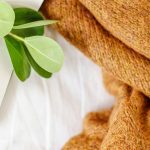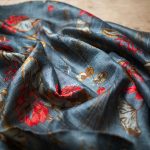The Official Robert Kaufman Kona Cotton Color Chart helps you pick exact fabric shades by grouping colors into families like Reds, Blues, and Neutrals for easy comparison. Each color has a unique code and inspiring name to simplify selection. The chart shows solids and tonals, so you’ll understand how to mix and match fabrics for quilts or projects. You can download it from official sources and keep it updated for the truest colors. Keep exploring to master coordinating your colors flawlessly.
Table of Contents
Key Takeaways
- The Kona Cotton Color Chart shows each color in a square with a unique four-digit code and name for easy identification and matching.
- Colors are grouped by shade families and arranged by hue and tone from light to dark for clear comparison and selection.
- The chart distinguishes solid colors with uniform tones and tonal colors featuring shade variations, aiding in fabric coordination.
- Color codes remain consistent across collections, helping quilters organize, locate, and match fabrics precisely.
- The chart supports quilt planning by enabling selection of complementary, analogous, or tonal colors for balanced, harmonious designs.
Understanding the Layout of the Kona Cotton Color Chart
Although the Kona Cotton Color Chart might look overwhelming at first, understanding its layout makes selecting colors much easier.
When you open the chart, you’ll notice it displays each color in a small square alongside its unique number and name. This lets you quickly identify and reference colors without confusion.
The chart is designed to showcase every shade clearly, so you can compare options side by side. You’ll also find that the chart is printed on sturdy paper, giving you a true representation of the fabric’s texture and finish.
Having this visual guide handy allows you to make confident color choices, whether you’re planning a quilt, garment, or craft project. It’s your essential tool for smooth fabric selection.
How Colors Are Organized in the Chart
You’ll notice the colors are grouped by similar shades, making it easier to find what you need.
The chart arranges hues and tones systematically, so you can compare variations at a glance.
Understanding this layout helps you navigate the wide range of Kona Cotton colors with confidence.
Color Groupings Overview
When you explore the Kona Cotton Color Chart, you’ll notice the colors are grouped to make choosing your fabric easier.
These groupings help you quickly find the shade you want without scanning the entire chart. The chart organizes colors into distinct, easy-to-navigate sections based on their general characteristics.
This thoughtful layout lets you compare related hues side-by-side and plan your projects more efficiently.
Here’s how the colors are grouped:
- Whites and Neutrals – Soft, versatile basics.
- Pinks and Reds – Bold and vibrant tones.
- Blues and Greens – Cool, calming shades.
- Yellows, Oranges, and Browns – Warm, earthy colors.
This system simplifies your selection process, making fabric shopping both faster and more enjoyable.
Hue and Tone Arrangement
Because the Kona Cotton Color Chart arranges colors by hue and tone, you can easily spot subtle differences and find the perfect shade for your project. The chart groups colors horizontally by hue—from warm reds to cool blues—and vertically by tone, ranging from light to dark. This systematic layout helps you compare shades side-by-side, making color selection straightforward. For example, you might see a light pink next to a medium rose and a deep burgundy, illustrating the tone progression within the red hue.
| Light Tone | Medium Tone | Dark Tone |
|---|---|---|
| Pale Peach | Coral Pink | Deep Rose |
| Sky Blue | Royal Blue | Navy Blue |
| Mint Green | Forest Green | Olive Green |
This arrangement simplifies your decision-making and sparks creativity.
Chart Layout Structure
Although the Kona Cotton Color Chart may look complex at first, its layout follows a clear and logical structure that helps you navigate through the wide range of colors easily.
The chart organizes colors by grouping related hues and tones in a way that makes it simple to compare and select shades. You’ll find the colors arranged systematically, allowing you to quickly identify complementary or contrasting options.
Here’s how the chart’s structure breaks down:
- Colors are grouped by hue families, like reds, blues, and greens.
- Within each family, shades shift from light to dark.
- Neutral shades are positioned separately for easy reference.
- Each color square includes a unique name and number for precise identification.
This setup guarantees you can find the perfect Kona Cotton color without confusion.
Decoding the Color Codes and Names
You’ll find that each Kona Cotton color comes with a unique code that helps you identify it quickly.
The color names often reflect the shade’s inspiration or mood, making it easier to visualize.
Let’s break down how to read these codes and what the names really mean.
Understanding Color Codes
When you explore Kona Cotton, you’ll notice each color comes with a unique code that helps identify it precisely. These codes are essential for ordering and matching fabrics accurately.
Here’s what you need to know about understanding these color codes:
- Numeric Format: Each color has a four-digit number, making it easy to reference and reorder.
- Consistency: The code stays the same across different collections, ensuring you get the exact shade every time.
- Cataloguing: Codes help retailers and quilters organize and locate fabrics quickly.
- Avoid Confusion: Since some colors look similar, relying on the code prevents mistakes when selecting or purchasing.
Meaning Behind Names
Understanding the numeric codes gives you a clear way to identify Kona Cotton colors, but the names themselves also carry meaning that can help you connect with the fabric on a different level.
Robert Kaufman often chooses names inspired by nature, emotions, or cultural references, making each shade more memorable. When you see names like “Juniper,” “Storm,” or “Buttercup,” you get a vivid sense of the color’s mood or tone, beyond just its appearance.
This naming approach helps you visualize the fabric’s potential in your project, whether it’s calming, vibrant, or earthy. So, when selecting Kona Cotton, don’t just rely on numbers—embrace the stories behind the names to enhance your creative process.
The Role of Color Families in Fabric Selection
Because color families group hues with similar tones and moods, they play an essential role in fabric selection.
When you understand these families, you can quickly narrow down choices and create harmonious designs. Here’s how color families help you:
- Simplify Decisions – Picking from a family reduces overwhelm by focusing on related shades.
- Ensure Cohesion – Fabrics within a family naturally complement each other, improving overall balance.
- Set Mood and Style – Each family evokes specific feelings, so you can match fabric to your project’s vibe.
- Enhance Coordination – Combining fabrics from the same family makes mixing and matching easier.
Tips for Matching Kona Cotton Colors
When matching Kona Cotton colors, you’ll want to check for color consistency to guarantee your project looks polished.
Pay attention to coordinating complementary shades that enhance each other without clashing.
These simple tips can help you create a balanced and vibrant fabric combination.
Color Consistency Tips
Matching Kona Cotton colors can be tricky, but a few key strategies will help you maintain color consistency throughout your project.
First, always purchase enough fabric from the same dye lot to avoid subtle color variations.
Second, use natural light when comparing swatches to see true colors without distortion.
Third, pre-wash your fabrics to avoid unexpected fading or bleeding that can alter your final palette.
Finally, keep your color chart handy as a reference to double-check hues before cutting or sewing.
By following these steps, you’ll guarantee your project looks cohesive and vibrant, avoiding mismatched sections and frustrating surprises.
Staying consistent will make your finished piece look professional and polished every time.
Coordinating Complementary Shades
Maintaining color consistency sets a strong foundation, but pairing Kona Cotton shades thoughtfully will elevate your project even more.
To coordinate complementary shades, look for colors opposite each other on the color wheel—like deep navy with bright orange or soft lavender paired with lemon yellow. These contrasts create vibrant, balanced designs that catch the eye.
You don’t have to stick strictly to opposites, though; analogous colors, which sit side-by-side on the wheel, bring harmony and subtle depth. Experiment with different intensities within the same hue family to add interest without clashing.
Always test your chosen shades together under good lighting before cutting fabric. By carefully selecting complementary Kona Cotton colors, you guarantee your quilt or sewing project feels cohesive, dynamic, and professionally crafted.
Using the Chart to Plan Quilt Color Schemes
How do you choose the perfect colors to bring your quilt to life? The Kona Cotton Color Chart is your go-to tool for planning vibrant, harmonious color schemes. By referencing the chart, you can quickly identify shades that complement or contrast beautifully, ensuring your quilt has visual impact.
Use the Kona Cotton Color Chart to find vibrant, harmonious colors that make your quilt truly stand out.
Here’s how to use the chart effectively:
- Identify your primary color and locate it on the chart.
- Pick complementary or analogous colors nearby to create balance.
- Consider tonal variations for depth without overwhelming your design.
- Test small fabric swatches together to confirm your scheme before cutting.
Using the chart this way helps you make confident, creative choices that elevate your quilting projects from simple to stunning.
Differences Between Solids and Tonal Colors
Although both solid and tonal colors play essential roles in quilting, understanding their differences can help you make smarter choices for your designs. Solids offer consistent, flat color, making them perfect for backgrounds or bold statements. Tonals, on the other hand, feature subtle variations and texture, adding depth and interest to your quilt.
| Aspect | Solid Colors |
|---|---|
| Appearance | Uniform, flat color |
| Use | Backgrounds, bold shapes |
| Effect | Clean, simple, striking |
| Emotion | Calm, balanced, stable |
| Aspect | Tonal Colors |
| Appearance | Varied shades within one color |
| Use | Texture, dimension, subtle detail |
| Effect | Rich, dynamic, inviting |
| Emotion | Warm, cozy, nuanced |
How to Use the Chart for Coordinating Fabrics
When you start selecting fabrics, the Kona Cotton Color Chart becomes an invaluable tool to guarantee your choices harmonize well. It helps you visualize how different shades work together before purchasing.
To use it effectively:
- Identify your main color and find it on the chart for reference.
- Look at adjacent colors to find complementary or analogous shades for subtle blends.
- Contrast with colors opposite your main choice on the chart to create bold combinations.
- Use tonal variations within the same color family for depth and texture without overwhelming your design.
Where to Find and Download the Official Chart
Wondering where you can get the official Kona Cotton Color Chart? You can easily find and download it directly from Robert Kaufman’s website. They offer a PDF version that’s regularly updated, ensuring you have the most accurate colors at your fingertips. Besides the official site, trusted fabric retailers often provide the chart too, which is handy when shopping.
Here’s a quick guide to where you can download the chart:
| Source | How to Access |
|---|---|
| Robert Kaufman Website | Visit the “Resources” or “Downloads” section |
| Authorized Retailers | Check their fabric or tools pages |
| Quilting Forums | Look for shared links from members |
| Social Media Groups | Join Kona cotton communities for updates |
Make sure to download from reliable sources to avoid outdated charts.
Maintaining and Updating Your Color Chart Collection
Since color availability can change with new dye lots and seasonal releases, you’ll want to keep your Kona Cotton color chart up to date.
Regularly updating your collection guarantees you’re working with the most accurate color references and helps avoid mismatches in your projects.
Keeping your collection current ensures precise color matching and flawless project results every time.
Here’s how to maintain and update your color chart effectively:
- Check Robert Kaufman’s official website periodically for new releases or updates.
- Replace outdated or faded swatches with fresh samples from your latest fabric purchases.
- Organize your charts by date or version to track changes over time.
- Store your charts in a cool, dry place away from direct sunlight to prevent color fading.
Frequently Asked Questions
What Is the History Behind the Kona Cotton Brand?
Ever wondered why Kona Cotton feels so timeless? You’ll find it was born from Robert Kaufman’s passion for quality quilting fabrics, evolving since the 1990s into an iconic, vibrant staple loved by crafters worldwide.
How Is Kona Cotton Fabric Produced?
You’ll find Kona cotton fabric is produced from high-quality cotton grown mainly in California and Arizona. The fibers are carefully harvested, spun into yarn, then woven to create a smooth, durable, and vibrant fabric perfect for quilting.
Are Kona Cotton Fabrics Eco-Friendly or Sustainably Made?
Sustainability shines subtly in some Kona cotton fabrics, but you shouldn’t assume all are eco-friendly. While certain producers prioritize planet-positive practices, it’s wise to watch for certifications and inquire about individual brands’ environmental efforts before buying.
Can Kona Cotton Colors Fade After Washing?
You might notice Kona cotton colors fading after washing if you use harsh detergents or hot water. To keep colors vibrant, you should wash in cold water, use gentle detergents, and avoid prolonged sun exposure.
What Are Common Uses for Kona Cotton Beyond Quilting?
You can use Kona cotton beyond quilting for making clothing, home decor like pillow covers, tote bags, and crafts. Its soft texture and vibrant colors make it perfect for various sewing projects you’ll enjoy creating.
- The Use of Nonwovens in Construction and Civil Engineering - July 11, 2025
- The Use of Nonwovens in Construction and Civil Engineering - July 11, 2025
- The Use of Nonwovens in Construction and Civil Engineering - July 11, 2025







